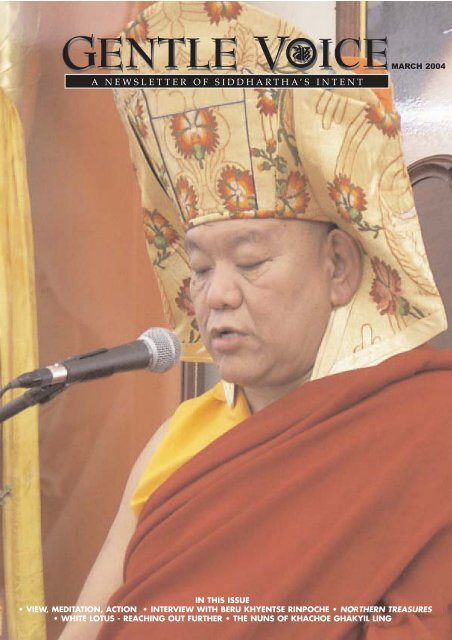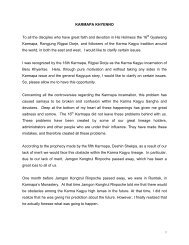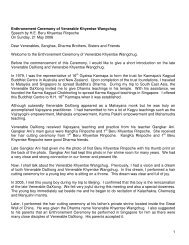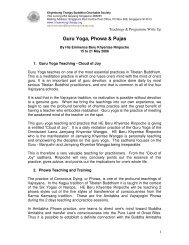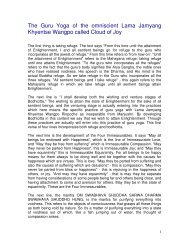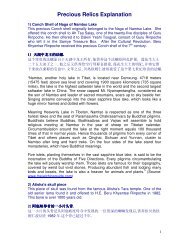An interview with H.E. Beru Khyentse Rinpoche - Khyenkong Tharjay
An interview with H.E. Beru Khyentse Rinpoche - Khyenkong Tharjay
An interview with H.E. Beru Khyentse Rinpoche - Khyenkong Tharjay
- No tags were found...
Create successful ePaper yourself
Turn your PDF publications into a flip-book with our unique Google optimized e-Paper software.
danger of dying out. He would receive that lineage andthen write it down in book form and teach it again. Alllineages of the Nyingma, Kagyü, Sakya and Gelug as wellas the Shangpa, Drigung, Jodruk (Kalachakra) and Chöhe searched out, received and also practised and thentransmitted to his disciples. So he was a very greatmaster.His Holiness the Sixteenth KarmapaAssamese border. The Karmapa escaped south throughBhutan. We however went through northern Tibet. Wetravelled for one and a half years, living in tents andtravelling on horseback. In 1959 we reached Nepal. Thenat the time of the New Year, Losar, I met the Karmapaagain in Nepal. We were all safe and didn’t have anyproblems <strong>with</strong> the Chinese, but many other monasteries’lamas and many lay people died. When we were nearNyenchen ThangLha’s mountain, reconnaissanceaeroplanes flew overhead. We heard them coming andwere able to cover our belongings <strong>with</strong> cloth so theycouldn’t see us and they didn’t drop bombs on us. Wewere very lucky. The next day we left. At that time, atChegu Gonpa in Kongpo, there were many people killed.<strong>Rinpoche</strong>, you are the speech emanation of Jamyang <strong>Khyentse</strong>Wangpo. Could you say something about the rimé or nonsectarianlineage, as it seems very important at this time?Yes. The background to the <strong>Khyentse</strong> lineage is that at thetime of the Buddha he was Manjushri. Then throughmany different lifetimes he was Manjushrimitra,Vimalamitra, Dril Bupa, (or Vajra Ghantipa), Bana Ratna(or Pal Yang) and many, many great yogis. In Tibet, thefirst time, he reincarnated as King Trisong Deutsen. Fromthe king emanated five forms of his body, speech, mind,qualities and activities. Then, there are the 108 majortertöns (treasure revealers) and the 1,022 minor tertöns. Ofthe major tertöns in the past lives of Jamyang <strong>Khyentse</strong>Wangpo, the first was Sangye Lama, who was the firsttertön in Tibet (Tsa Sum Dril Drub was one of his termas),then Nyang Ral Nyima Öser and Guru Chöwang.Jamyang <strong>Khyentse</strong> Wangpo was a very great master andhad over 150 different lineage gurus. He travelled all overTibet to receive and thereby preserve all of the lineagetransmissions, some of which were almost broken and in(Photo courtesy of Sonam and Tenzin)At the same time, Jamgön Kongtrül Lodrö Thaye (1813 –1899) was his dharma brother and they were each other’sdisciples and gurus. The first Jamyang <strong>Khyentse</strong> Wangpolived for seventy-three years from 1820 to 1892. Before hedied, he practised Vimalamitra’s guru yoga and said heknew that it was his time to go and that he woulddissolve into Vimalamitra’s heart and go to Vimalamitra’ssacred place, the five peaks of Wu Tai Shan in China.Then he would again radiate five emanations. So thereare five <strong>Khyentse</strong>s. His main seat was at Dzongsar TashiKartsey. The holder of this seat, the second Dzongsar<strong>Khyentse</strong>, died at the age of thirteen, after which theSakyas invited the Kathog <strong>Khyentse</strong> to Dzongsar tobecome the throne-holder there. This was Jamyang<strong>Khyentse</strong> Chökyi Lodrö. He was also very great and hadmany teachers from different lineages as had Jamyang<strong>Khyentse</strong> Wangpo before him. His activities greatlyflourished and he had many, many disciples, both tulkusand khenpos.The first <strong>Beru</strong> <strong>Khyentse</strong>, my previous incarnation, wasborn in 1896. He was recognised by the first JamgönKongtrül Lodrö Thaye as the speech incarnation ofJamyang <strong>Khyentse</strong> Wangpo. The boy was taken toPalpüng monastery and was given the name PemaWangchüg. He studied all the different traditions andbecame a great rimé master. He was considered the heartson of his main guru, the fifteenth Karmapa, KhakyabDorje.Later, the fifteenth Karmapa invited the first <strong>Beru</strong><strong>Khyentse</strong>, who was a monk, to come to his seat, Tsurphu,near Lhasa, and look after the monks and his sons anddaughters as his regent. Before passing away, the fifteenthKarmapa had a vision about the incarnation of thesixteenth Karmapa, which was recorded but was difficultto decipher. Eventually <strong>Beru</strong> <strong>Khyentse</strong> <strong>Rinpoche</strong> receiveda piece of paper containing the exact explanation of thereincarnation document. After he had read it, heunderstood the meaning and was very happy as he hadbeen searching for this key to open the code of thereincarnation letter left by the fifteenth Karmapa aboutthe sixteenth Karmapa. This is regarding the first <strong>Beru</strong><strong>Khyentse</strong>, the fifteenth Karmapa’s main heart son andalso the guru of the sixteenth Karmapa.<strong>Rinpoche</strong>, is there something you would like to say inconclusion?Yes. As the teachings of the buddha dharma spreadthroughout the West and the East, in Australia and NewZealand we really need to put into practice theseteachings of the Buddha. This is a really momentous time.There are many great masters giving teachings here.These teachings are very precious and now you have thecontinued page 10Gentle Voice - 5
continued from page 3S: I’m wondering how important the view really is.Cannot someone be a perfectly normal person, <strong>with</strong>outhaving such and such beliefs, <strong>with</strong>out following such andsuch a view? Or is it really important and one has to tryand structurise one’s view to actually attain a certainnormality?R: When we are talking about the view, there are manydifferent levels of view. Of course, everybody has a view.A view is basically an idea and based on that idea wefunction. For instance, BMW is a great car. That’s a view.Then for days and nights you work hard to buy one.That’s meditation. <strong>An</strong>d finally you get one; then you’realways worried about how it will or won’t get scratched.That’s action. View, meditation and action. Everything hasthat. But, of course, Buddhists would dispute all the otherviews. They would say an ordinary view has a lot offaults. That’s why they call it the relative view. Why?Because maybe a year later you will not like your BMW;you will like Ferrari instead. Now that proves that BMWis not the ultimate happiness or the ultimate truth. Sowhat defines the ultimate view is something that will notchange, something that is not dependent on any othercause and condition.The Buddhist view of looking at phenomena is thateverything is impermanent, interdependent andthere's no such thing as a whole.So this is what I mean. Our view about our hand is totallywrong. We think this is the same hand as yesterday’shand. If I ask you, ‘Were you there yesterday?’ youanswer, ‘Yes’, as if yesterday’s you and today’s you arethe same. But they are not. There you go. You have awrong view there! It’s a habit. <strong>An</strong>d then when I ask,‘Who’s this you?’ you point everywhere – to your toes,your nose, your chest. You have a whole abstract idea ofyou. That’s a wrong view again because there’s not asolid, tangible entity that you can refer to as you.<strong>An</strong>yway, let’s talk about action now. Again, the action hasto be based on the view. The view is the most importantthing, okay? Meditation is to get accustomed to this viewthat we have established. Action is also to enhance thisview. There are many Buddhist actions, such asmeditation, visualisation, compassion, generosity and soon. But all these Buddhist actions can be abbreviated intotwo things based on the view: outrageousness andelegance. Why outrageousness? It’s very necessarybecause if you are not outrageous, you will become aslave of this wrong view. You will want to wear a tie andthen you will spend the whole evening not knowingwhich tie to wear. You are losing it again here! Not beingoutrageous enough!If you are outrageous and you are maybe meeting theprime minister for dinner, you could wear a live fishbecause, based on the view, a live fish would be muchmore valuable than this useless piece of fabric. But, thenagain, action has to be accompanied by elegance. Why?Because as a Buddhist, as someone who knows what theview is, you have a responsibility. Compassion has to bethere. You should not go to dinner <strong>with</strong> a dead fishhanging around your neck. As a Buddhist you should not!You should wear a very elegant tie that will match yourshoes and your belt. You should put it on properly and allalong you should know, ‘I’m doing the most pathetic,useless thing that exists.’ These two things are theBuddhist action.So now just to summarise. The Buddhist view of lookingat our hand and at phenomena: everything isimpermanent, interdependent and there’s no such thingas a whole. That’s the view. Meditation is to enhance thisview. To get accustomed to this view you try to cut allthese inhibitions. But how? By doing nothing. Action is toenhance even more that view. You try to practiseoutrageousness and elegance together. You can’t practisethem one after the other. You have to practise themtogether.Of course, I didn’t do justice to the vast and deep wisdomof Shakyamuni. But I hope some of you can use thisapproach as the door to the infinite path of Buddhism.Thank you.(This teaching is also available as an audio tape fromSiddhartha’s Intent Southern Door, P.O. Box 1114, StrawberryHills, NSW, 2012, Australia.)continued from page 5opportunity to practise, so I wish that all of you disciplesmake efforts to wake up your minds and not be lazy. Yousee, you have all the conditions here, even more than inTibet, so <strong>with</strong> these good opportunities the time has nowcome to practise. The whole world is full of suffering andproblems, so we need to produce discipline in our mindsthrough the practice. All you Western dharma disciplesshould not squander your precious human rebirth, butinstead act appropriately and practise.In his message that the sixteenth Karmapa gave to me tobring in 1979, he said the following. ‘I am sending thisincarnation, <strong>Khyentse</strong> Chökyi Wangpo, (the present <strong>Beru</strong><strong>Khyentse</strong>), to Australia and New Zealand. I hope you canreceive teachings from him.’ He then explained about thefour foundation practices, the view according to theKagyü tradition, how to meditate on mahamudra andhow to apply this in one’s actions. At the end of thecassette he stated that in the future many people herewould practise the dharma and through this gainenlightenment. He dedicated his message in the followingmanner:In the way heroic Manjushri knows all,<strong>An</strong>d Samantabhadra too,I emulate their way<strong>An</strong>d fully dedicate this virtue.(The Gentle Voice would like to thank Douglas Mills for histranscription of this <strong>interview</strong>.)10 - Gentle Voice


